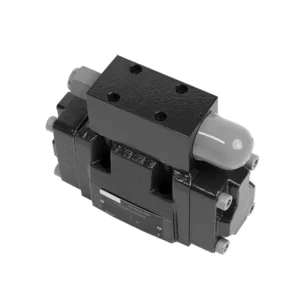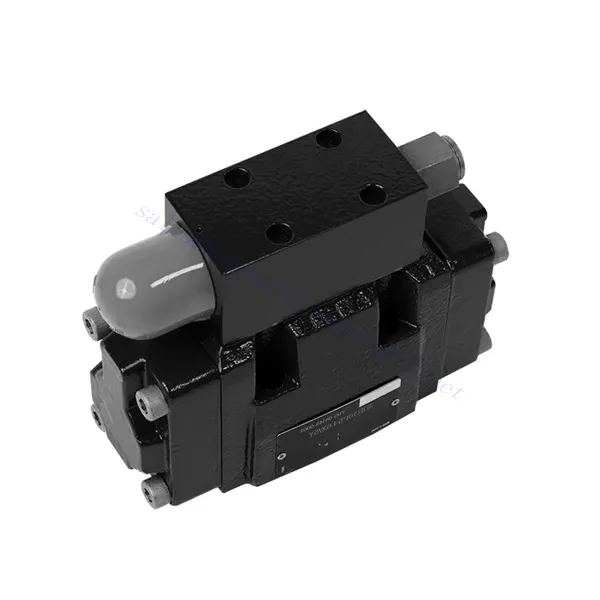3DR Series Pilot Operated Pressure Reducing Hydraulic Valve
En tant que fabricant, fournisseur et exportateur de produits mécaniques, nous proposons des vérins hydrauliques et de nombreux autres produits.
N'hésitez pas à nous contacter pour plus de détails.
Courrier :sales@hydraulic-cylinders.net
Fabricant fournisseur exportateur de vérins hydrauliques.
3DR Series Pilot Operated Pressure Reducing Hydraulic Valve

The 3DR series pilot-operated pressure-reducing hydraulic valve is a highly efficient and reliable component that delivers precise pressure control in hydraulic systems. With its advanced pilot-operated mechanism and exceptional performance, this valve ensures an accurate reduction of hydraulic pressure to meet specific system requirements.
The 3DR series pilot-operated pressure-reducing hydraulic valve is a high-performance solution for precise pressure control in hydraulic systems. Featuring a pilot-operated design, precise pressure control, wide pressure range, and high flow capacity, this valve ensures efficient and accurate pressure reduction while safeguarding system components. By following the recommended usage methods and maintenance practices, the 3DR series valve delivers reliable performance, extending the lifespan of hydraulic systems. Upgrade your hydraulic system with the 3DR series pilot-operated pressure-reducing hydraulic valve and experience optimal pressure control for enhanced system efficiency and productivity.
3DR Series Pilot Operated Pressure Reducing Hydraulic Valve Key Characteristics:
- Pilot-Operated Design:
- The 3DR series valve features a pilot-operated design, which enables it to provide accurate, stable, and reliable pressure reduction in hydraulic systems.
- It utilizes a separate control circuit, known as the pilot circuit, to regulate the opening of the main valve and control the pressure.
- Precise Pressure Control:
- This valve offers exceptional precision in pressure control, allowing hydraulic systems to operate within the desired pressure limits.
- It maintains consistent pressure levels, preventing over-pressurization and safeguarding sensitive system components.
- Wide Pressure Range:
- The 3DR series valve is available in various pressure ranges, making it suitable for various hydraulic applications.
- The flexibility in pressure range allows customization to match specific system requirements and optimize performance.
- High Flow Capacity:
- This valve exhibits excellent flow capacity, enabling it to handle high flow rates without compromising pressure control accuracy.
- It ensures efficient fluid regulation and uninterrupted system operation, even in demanding applications.
3DR Series Pilot Operated Pressure Reducing Hydraulic Valve Parameter:
| Specifications | NG10 | NG16 | ||
| Fluid | Mineral oil suitable for NBR and FKM seal | |||
| Phosphate ester for FKM seal | ||||
| Fluid temperature range | ℃ | -30 to +80 (NBR seals) | ||
| -20 to +80 (FKM seals) | ||||
| Viscosity range | mm2/s | 10 to 800 | ||
| Degree of contamination | Maximum permissible degree of fluid contamination: Class 9. NAS 1638 or 20/18/15, ISO4406 | |||
| Nominal pressure | bar | 315 | ||
| Max. operating pressure | Port P | bar | 315 | |
| Max. operating pressure | Port A | bar | 315 | 250 |
| Max. operating pressure | Port Y | bar | Separate and at zero pressure to tank | |
| Setting pressure | Min. | bar | Dependent on the flow (see curves) | |
| Max. | bar | 50; 100; 200; 315 | 50; 100; 200; 250 | |
| Max. flow-rate | L/min | 120 | 220 | |
| Weight | kg | about 6.5 | about 8.8 | |
3DR Series Pilot Operated Pressure Reducing Hydraulic Valve Advantages:
• Installation face follows DIN 24340 A and ISO 4401
• Four pressure ranges
• Two adjustment types: knob, adjustment screw with protection cap
• With pressure gauge interface
Usage Method Of 3DR Series Pilot Operated Pressure Reducing Hydraulic Valve:
- System Analysis:
- Conduct a comprehensive hydraulic system analysis to determine the specific pressure control requirements.
- Consider maximum operating pressure, desired pressure range, and flow rates.
- Valve Selection:
- Select the appropriate 3DR series valve variant based on the system’s pressure control specifications.
- Consider pressure rating, flow capacity, and compatibility with other system components.
- Installation:
- Follow the manufacturer’s instructions to correctly install the 3DR series pilot-operated pressure-reducing valve in the hydraulic system.
- Ensure proper alignment and secure connections to prevent leaks and optimize performance.
- Calibration:
- Calibrate the valve to set the desired downstream pressure.
- Use pressure gauges or other measurement devices to adjust the valve’s pilot circuit accurately.
How Does A Hydraulic Rupture Valve Work?
A hydraulic rupture valve, also known as a burst or pressure relief valve, is a safety device designed to protect hydraulic systems from catastrophic failure in the event of a sudden pressure surge or hydraulic line rupture. Its primary function is to limit the pressure within the system by diverting excess fluid flow when a predetermined pressure threshold is exceeded. Let’s explore how a hydraulic rupture valve works:
- Valve Construction:
- A hydraulic rupture valve typically consists of a valve body, a spring-loaded poppet or spool, and an adjustable spring.
- The valve body contains fluid ports for the inlet, outlet, and a drain or return line to the reservoir.
- Pressure Setting:
- The rupture valve has an adjustable spring that determines the pressure at which the valve opens.
- By adjusting the spring tension, the pressure threshold at which the valve will activate can be set according to system requirements.
- Pressure Monitoring:
- As the hydraulic system operates, the pressure level is constantly monitored.
- The rupture valve is connected to the system at a strategic location, such as downstream of critical components or in high-pressure lines.
- Pressure Surge or Rupture Detection:
- If a sudden pressure surge occurs or a hydraulic line ruptures, the pressure within the system rapidly increases beyond the set threshold.
- Valve Activation:
- When the pressure exceeds the set threshold, the force exerted by the system pressure overcomes the spring tension.
- This force causes the rupture valve to open, creating a path for excess fluid to flow out of the system and either return to the reservoir or a designated drain line.
- Fluid Diversion:
- By diverting excess fluid flow, the rupture valve effectively limits the pressure within the system, preventing further pressure buildup.
- This safeguards system components from damage and minimizes the risk of catastrophic failure.
- Pressure Equalization:
- As the excess fluid is diverted, the pressure within the system begins to equalize.
- Once the pressure drops below the set threshold, the spring tension overcomes the force exerted by the system pressure, causing the valve to close.
- System Restoration:
- After the rupture valve has closed, the normal flow of hydraulic fluid through the system is restored.
- The system can continue to operate, albeit at a reduced pressure level, until the cause of the pressure surge or rupture is addressed.
Capacité de l'usine :
(1) Assemblage
We have a first-class independent research and development assembly platform. The hydraulic cylinder production workshop has four semi-automatic lifting cylinder assembly lines and one automatic tilt cylinder assembly line, with a designed annual production capacity of 1 million pieces. The special cylinder workshop is equipped with various specifications of a semi-automatic cleaning assembly system with a designed annual production capacity of 200,000 and equipped with famous CNC machining equipment, a machining center, a high-precision cylinder processing special equipment, a robot welding machine, an automatic cleaning machine, automatic cylinder assembly machine, and automatic painting production line. Existing critical equipment of more than 300 sets (sets). The optimal allocation and efficient use of equipment resources ensure the accuracy requirements of products and meet the high-quality needs of products.


(2) Usinage
L'atelier d'usinage est équipé d'un centre de tournage sur rail incliné personnalisé, d'un centre d'usinage, d'une machine à honer à grande vitesse, d'un robot de soudage et d'autres équipements connexes, qui peuvent traiter des tubes cylindriques d'un diamètre intérieur maximal de 400 mm et d'une longueur maximale de 6 mètres.

(3) Soudage

(4) Peinture et revêtement
Avec des lignes de revêtement de peinture à base d'eau automatiques à cylindre de petite et moyenne taille, pour réaliser le chargement et le déchargement automatiques par robot et la pulvérisation automatique, la capacité de conception est de 4 000 pièces par équipe ;
Nous disposons également d'une ligne de production de peinture semi-automatique pour gros cylindres, alimentée par une chaîne de traction, d'une capacité de conception de 60 caisses par équipe.


(5) Essais
Nous disposons d'installations d'inspection et de bancs d'essai de premier ordre pour garantir que les performances de la bouteille sont conformes aux exigences.

We are one of the best hydraulic cylinder manufacturers. We can offer comprehensive hydraulic cylinders. We also provide corresponding boîtes de vitesses agricoles. We have exported our products to clients worldwide and earned a good reputation because of our superior product quality and after-sales service. We welcome customers at home and abroad to contact us to negotiate business, exchange information, and coopérer avec nous!
Visitez notre usine de RV :
Visitez notre usine de RV avec les éléments suivants
Vérin hydraulique Application :


